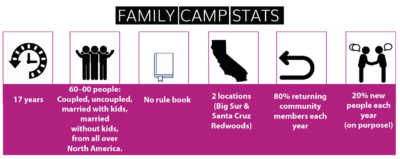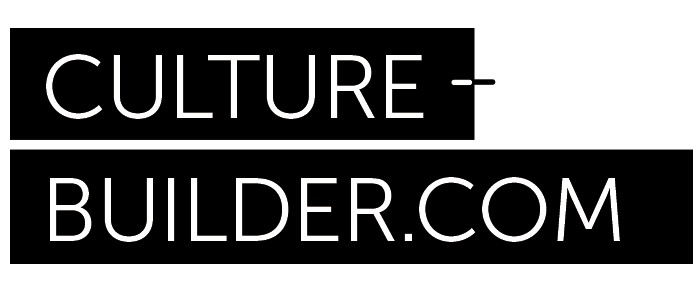Most people can’t imagine spending a week in the woods with their families. There can be challenging dynamics at play that make family vacations not feel like vacations.
But with a shared purpose and a co-created “culture code,” we were able to upgrade our annual gathering in the redwoods into a deeply nourishing experience of community.
Since 2002, eighty of us have gathered in the redwoods to practice community. On the surface, it looks like a “glamping trip” with lots of people. But if you really pay attention, there is a whole lot more going on.
It’s part hanging out with friends and family, part digital detox, and part workshop on how to live in community. We call it family camp.
It’s a multigenerational gathering with families of all ages including elders and children. My daughters grew up here. In fact, at 24 and 26 years old they still insist on coming back. They know their friends will be there. They know it will be one the best weeks of their year.
We are not a community that lives together (we come from all over North America), or a community born out of a single teacher, practice or philosophy. What we have in common is that we care deeply about the experience of community for ourselves and our loved ones.
This community is a case-study in how to create a group culture that is
a.) self sustaining
b.) leaderful
c.) inspires learning and growth
First the Data:

Family Camp Culture Code
Values
- Community –We are all connected, dependent, independent and interdependent. No one is a stranger, even if we haven’t met before.
- Authenticity –Being real, honesty, telling the truth.
- Inclusion –Inclusion is a two-way street. Include yourself, include others.
- Ownership –“There are no passengers…Only crew.”
- Discovery/Growth –In community, I see myself more clearly.
- Fairness –Not entitlement, rather equal opportunity and equal treatment
- Fun –What naturally happens when we feel connected and safe.
Practices
- We honor and accept our “different-ness” and our sameness. We welcome diversity.
- We listen generously
- We speak straight (no gossip) and support others to do the same.
- We work it out (so that we don’t act it out). Conflict happens. We embrace it as an opportunity to grow individually and collectively.
- We keep our agreements with each other.
- We trust the process (everything that happens or doesn’t happen is part of the process)
- We include others and include ourselves
Setting expectations and context
Although we are inclusive and welcome everyone at Family Camp, we have noticed that there is such a thing as culture fit at our gathering. We’ve had people come who didn’t understand what we were doing and chose to leave early. It has to be a culture fit for people to enjoy it.
In some ways, Family Camp is like Burning Man because there are many people who already embody the culture. The way that we interact, listen, and speak to each other is clear to anyone paying attention, and it is contagious. In other words, the veterans are the culture builders.
In order to set the expectation and context for inclusion throughout the week, the leaders welcome people as they arrive, and we have culture of excitement around the welcoming process. When people arrive, everyone knows that they arrived, and more importantly, they know that they arrived somewhere welcoming. This culture of inclusion creates a feeling of excitement and belonging.
We continue the welcoming process by holding an opening circle where we name the intention and purpose of the camp. The idea is, “include others and include yourself.” This places 100 percent responsibility on all of us to create a community feeling amongst us.
In addition, each morning, we hold a meeting we offer gifts, share appreciation, feedback, impact, and metabolize friction to keep the space clear and continue fostering the culture that we want.
The rest of our time is unstructured. We think we have found just the right balance between intentional and unstructured time together. Too much structure, and it starts feeling too artificial and more like a workshop; Not enough structure, and it starts feeling too shallow.
Some of our greatest accomplishments:
A deep experience of feeling part of, connected to our larger tribe. Most people get used to feeling separate. It is such a constant and common experience that most of us have stopped questioning it or believing it could be different. Our world certainly reinforces this: Separate cars, rooms, gate communities, fences. A busyness that keeps us task-focused, and a culture that all but ignores (let alone encourages) togetherness.
Creating a ‘Leaderful’ culture. What is especially extraordinary about this gathering is how it has persisted and grown and thrived without one consistent leader.
Behind many thriving group, team or company cultures you will usually find an inspired leader who embodies the culture and who is a constant driver of it. Not that they complain—it’s a labor of love. The downside of the culture via inspired charismatic leader is that when they leave, the community often doesn’t survive.
At Family Camp, we do it differently. Instead of one consistent leader, every year we have a three-person leadership team. The team consists of the current source (organization) person, immediate past source person, and incoming source person. They in turn have a team of people (all volunteer) that support their vision for camp.
Each new leader gets to shape that year’s themes and activities while staying true to our bedrock principles and bringing in new and inspired ideas. Over the last 17 years, we have had 13 different people assume the leadership role at camp.
Modeling what it takes to create a sense of community for the next generation. Some of our kids have been attending since they were toddlers. Now, not only do they insist on coming back every year, but they are leading community meetings and taking on leadership roles for organizing camp.
Each year, I leave our time together, full of heart and a little tired from staying up so late and enjoying my people. I have found (or co-created along with 80 others), a place that I get to be the best version of myself.
Here are some ways culture builders can take the lessons of family camp to work:
- Do you have a clear shared purpose?
- Have you created a Culture Code or team charter?
- Do you take turns leading? How can you create a culture that is “leaderful”?
- Have you created rituals for getting connected when you gather and welcoming new people?
- Are you balancing time for “intentional conversations” with time for free-form social conversations?
Get the Culture Building Report

You'll learn the road map for designing, embedding and activating culture in your team or company.

